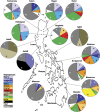Complete mtDNA genomes of Filipino ethnolinguistic groups: a melting pot of recent and ancient lineages in the Asia-Pacific region
- PMID: 23756438
- PMCID: PMC3895641
- DOI: 10.1038/ejhg.2013.122
Complete mtDNA genomes of Filipino ethnolinguistic groups: a melting pot of recent and ancient lineages in the Asia-Pacific region
Abstract
The Philippines is a strategic point in the Asia-Pacific region for the study of human diversity, history and origins, as it is a cross-road for human migrations and consequently exhibits enormous ethnolinguistic diversity. Following on a previous in-depth study of Y-chromosome variation, here we provide new insights into the maternal genetic history of Filipino ethnolinguistic groups by surveying complete mitochondrial DNA (mtDNA) genomes from a total of 14 groups (11 groups in this study and 3 groups previously published) including previously published mtDNA hypervariable segment (HVS) data from Filipino regional center groups. Comparison of HVS data indicate genetic differences between ethnolinguistic and regional center groups. The complete mtDNA genomes of 14 ethnolinguistic groups reveal genetic aspects consistent with the Y-chromosome, namely: diversity and heterogeneity of groups, no support for a simple dichotomy between Negrito and non-Negrito groups, and different genetic affinities with Asia-Pacific groups that are both ancient and recent. Although some mtDNA haplogroups can be associated with the Austronesian expansion, there are others that associate with South Asia, Near Oceania and Australia that are consistent with a southern migration route for ethnolinguistic group ancestors into the Asia-Pacific, with a timeline that overlaps with the initial colonization of the Asia-Pacific region, the initial colonization of the Philippines and a possible separate post-colonization migration into the Philippine archipelago.
Figures




References
-
- Scott WH. Prehispanic Source Materials For the Study of Philippine History. Quezon City, Philippines: New Day Publishers; 1984.
-
- Détroit F, Dizon E, Falguères C, Hameau S, Ronquillo W, Sémah F. Upper Pleistocene Homo sapiens from the Tabon cave (Palawan, The Philippines): description and dating of new discoveries. C R Palevol. 2004;3:705–712.
-
- Mijares A, Détroit F, Piper P, et al. New evidence for a 67,000-year-old human presence at Callao Cave, Luzon, Philippines. J Hum Evol. 2010;59:123–132. - PubMed
-
- Lewis MP.(ed): Ethnologue: Languages of the World, Sixteenth edition. Dallas, TX: SIL InternationalOnline version http://www.ethnologue.com/ , 2009
-
- Reid LA.Unravelling the linguistic histories of Philippine Negritosin: Dutton T, Tyron DT (eds): Language Contact and Change in the Austronesian World Mouton de Gruyter; 1994443–475.
Publication types
MeSH terms
Substances
LinkOut - more resources
Full Text Sources
Other Literature Sources

